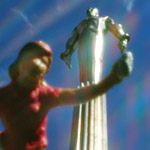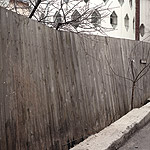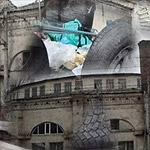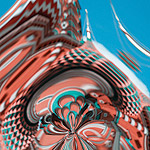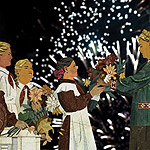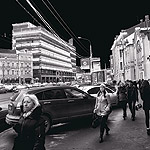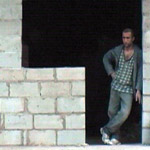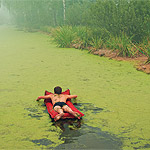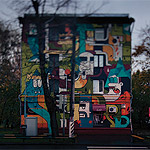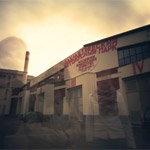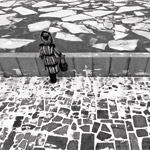Days of Moscow in Delhi. Walk About Moscow Exhibition Project
 The Moscow City Government
The Moscow City Government
The Moscow City Culture Department
Days of Moscow in Delhi
A Walk About Moscow Exhibition Project
Dates: October 26 — November 4, 2012
Location: Lalit Kala Academi (35, Ferozeshah Road, New Delhi)
Curators: Olga Shishko, Elena Rumyantseva
“A Walk About Moscow” — an exhibition project about the Russian capital — will be presented specially for the “Days of Moscow” festival programme in New Deli.
Moscow is a city of contrasts. Its architectural image, like a magic mirror, reflects all the historical, political and economic processes of the past and those still on-going in Russia the vast and multinational.
Photographs and video art works by fourteen artists will be presented at the exhibition. All these artists have their own view point, their own Moscow. From black and white graphics to blurred painting, from close-up to panoramic views, from captured details to multicolored panels...
The avant-garde style of contemporary buildings and the breathtaking rhythm of present-day highways in Dmitry Zverev’s works goes well together with wooden churches and art-noveau architecture in Yuri Avvakumov’s photos or details of old Moscow by Vladislav Efimov. Another series by Alexey Korsy and Sofia Gavrilova tells us the story of the All-Union Exhibition of Achievements of National Economy (VDNKh) — an ideal world, a grand model of the future as it was planned by its architects, today still partly retaining its flawless forms in spite of many alterations and re-naming. The Soviet ideological decor and a classic tradition, symbols of peasant culture and grandiose architectural forms are united in a unique harmony turning the VDNKh into a finished and autonomous project — a visual and spacial textbooks of morphogenesis.
“A Walk About Moscow” project deals not only with architecture and its representations. There’s a place here for people, too. Сharacters caught in Ludmila Zintchenko’s shots are surprisingly languorous or else there wouldn’t be a trace of them left, as exposure time here is measured in tens of seconds. Photographs by Irina Alayeva depict typical “tourist scenes” but human tourists are replaced by plastic toy figurines that seem to visit the city, and Moscow itself becomes an unexpected element in the games of imagination played by both photographer and viewer...
Four video works presented at the exhibition complete the image of Moscow. In Elena Gorbacheva’s work architecture comes alive and turns into a whole dancing canvas, Marina Fomenko shows transformations of an old building that loses its individuality in its interactions with everyday life, Ilya Korobkov uses the mosaic of Moscow metro as a basis, turning it into a symbol of a new united world, while Alexandra Mitlyanskaya tells a story of a new Babylon under construction.
Works by: Yuri Avvakumov, Alla Afonina, Irina Alayeva, Sofia Gavrilova, Elena Gorbacheva, Vladislav Efimov, Dmitry Zverev, Ludmila Zintchenko, Ilya Korobkov, Alexey Korsy, Tatiana Liberman, Alexandra Mitlyanskaya, Konstantin Semin, Marina Fomenko, Vladimir Yudanov.
A two-day workshop by the famous Russian photographer Vladislav Efimov will also be a part of the exhibition project. Vladislav Efimov will talk on the role of photography in contemporary art, his own work and works by young artists. This workshop presupposes live communication, and will be an excellent opportunity to meet the master and ask him questions.
 Alla Afonina, Sofia Gavrilova, Vladislav Efimov, Alexey Korsi
Alla Afonina, Sofia Gavrilova, Vladislav Efimov, Alexey Korsi
From the VDNKh series
2008
An ideal world, a grand model of the future as the All-Union Exhibition
of Achievements of National Economy (VDNKh) was planned by its architects, today still partly retaining its flawless forms in spite of many alterations and re-naming. The Soviet ideological decor and a classic tradition, symbols of peasant culture and grandiose architectural forms are united in a unique harmony turning the VDNKh into a finished and autonomous project — a visual and spacial textbooks of morphogenesis.
Alla Afonina is a photographer, currently a student at the Rodchenko Moscow School of Photography and Media Arts. Participant, co-ordinator and curator of regional projects in Udmurtia, Bashkiria and Samara. Participated in many exhibitions at NCCA (Moscow), ARTPLAY Design Centre (Moscow), Mikola’s House Gallery (Kiev, Ukraine), Manege Central Exhibition Hall (Moscow), participated in the Moscow Photobiennale 2010.
Sofia Gavrilova is a phototgrapher and curator. Studied at the Rodchenko Moscow School of Photography and Media Arts. Has exhibited at BrownStripe Gallery, Open Studio (New York), NCCA, Multimedia Art Museum, Moscow and MMOMA (Moscow). Participated at the Moscow Biennale for Young Art (2010, 2012) the 4 Moscow Binnele for contemporary art (2011), winner of the Silver Camera 2011 competition, nominated for the Kandindky prize 2012. Curated the Cinema.Direction project at the Photobiennale 2012. Her works are in the MAMM collection.
Vladislav Efimov is a photographer and artist. Studied at the Academy of the Arts, Berlin (1995—1996). More than 30 solo and group exhibitions in Moscow, Saint-Petersberg and Berlin. Winner of the Russian State Innovation Competition in the “Work of Visual Art” nomination (2008). His works are in the collection of the Russian Museum, the Centre Pompidou, Paris, MMOMA and other museums.
Alexey Korsi is a photographer, curator and artist. Studied at the Rodchenko Moscow School of Photography and Media Arts. Participated in numerous projects in various exhibition spaces: ARTPLAY (Moscow), NCCA (Moscow), Multimedia Art Museum (Moscow), Zurab Gallery, Vinzavod Centre for Contemporary Art (Moscow) and others. Curated the Barbarians exhibition (Moscow, PROEKT_FABRIKA, Special programme at the 3 Moscow Biennale for Young Art) and other projects.
From The Tourists series
2008
The photographs of this series show typical “sightseeing-sceneries”, but the place of real tourists is taken over by toy-figurines. Pictures are shot with an old, soviet “FED”-camera, which was converted into a camera obscura, a primitive pinhole camera without lenses. Due to its special optical features, reality and “toy-world” merge into one: figurines seem to walk about the city, and Moscow’s well-known sights suddenly acquire a slightly unreal, fantastical touch... capturing anew the imagination of the photographer and the spectator.
Irina Alayeva was born in Moscow in 1983. Environmental engineer by first education, she graduated in 2009 from the Rodchenko Moscow School of Photography and Media Arts. Took part in group exhibitions in Russia and Europe. Member of the Black Hole art group. Occasionally works as a photographer for the Goethe Institut Moscow.
From the Tsiolkovsky: Cenotaph series
2011
Yuri Avvakumov’s project explores architecture and its representation and illustrates the “Russian” view on architecture: upwards from down below.
Yuri Avvakumov is an architect, artist and curator. He is considered to be one of the famous contemporary Russian architects, though paradoxically he has not built a single house during his career — Avvakumov’s greatest achievement is that he transferred to the Russian soil the idea of paper architecture, that is of avant-garde creative projects not intended for realization. This construction on paper which started as student rebellion as opposed to the architectural stasis of the Soviet 1980’s is now acknowledged as classical and projects from those years are part of major museum’s collections. At the height of Perestroyka many of the “paper architects” opened their own bureaus and turned to practical activities, and Avvakumov went freewheeling, designed about a hundred exhibitions as an architect, took part in about five hundred as an artist and realized about fifty as a curator. He has twice represented Russia at the Venice Biennale.
Details of Moscow series
2008
This is a project about everyday life. A range of photographs show an apathetic everyday attitude to the reality of a person going his familiar urban way and only occasionally paying attention to the city that is moving along his way. His glance is usually directed at the middle point of the surrounding space and to the ground, and only sometimes upwards. The construction of human body itself makes him treat his position in the city this way, especially in the absence of vivid impressions. This work is about optional looking about and subsequent reflections of an observer.
“Details of Moscow” upholds the idea of a mid-point, a potential space that engenders everything bright and engaging behind our back. In this case there is no need in curiosity or a desire to get impressions, the body itself finds and feels what is necessary.
Vladislav Efimov is a photographer and artist. Studied at the Academy of the Arts, Berlin (1995—1996). More than 30 solo and group exhibitions in Moscow, Saint Petersburg and Berlin. Winner of the Russian State Innovation Competition in the “Work of Visual Art” nomination (2008). His works are in the collection of the Russian Museum, the Centre Pompidou, Paris, MMOMA and other museums.
Depot
2012
Video, 5’00”
Here we watch the architectural transformations of an old building that loses its individuality in its interactions with everyday life. The inevitable invasion of modern age into the flesh of the architectural monument brings to life a convincingly absurd object.
The Moscow Circular Steam Train Depot of the Nicolaevskaya railway was built in mid-nineteenth century and since than it has undergone many alterations. From a train depot it has been turned into a chaotic communal apartment of small shops, restaurants, warehouses, an auto repair shop and an inescapable dump. Now it is empty and will probably soon disappear.
Marina Fomenko is a curator, artist, founder and director of the NOW&AFTER Festival. She had solo exhibitions at the State Museum for Contemporary Art at the Russian Academy of Art and MMOMA. Nominee of The One Minutes Awards 2012 prize (Amsterdam, Netherlands), Kandinsky prize (2011). Participated in numerous exhibition projects and festivals: the Moscow Biennale for Contemporary Art, Media Forum MIFF, 13th Media Art Biennale WRO (Wroclaw, Poland), Festival des Cinemas Differents de Paris (Paris, France) and many others. She lives and works in Moscow.
Chronos. Moscow
2012
Three-channel video
Everything is born and disappears in time.
Architecture is immobile, monumental and durable. Sometimes we see it as a giant stage setting of our lives. But for Chronos a live of any great cathedral is just as a brief flight of a bird. “Fluid”, dancing architecture is a metaphor of the spatio-temporal continuum from the viewpoint of the cosmic time passage.
As one with the cosmic rhythm there’s a unique sound flow — as buildings throb, breathe, appear and disappear, like all living things do. Everything has its finiteness an infinite number of times. This is the common breathing of creation. All unique features and history of each building merge together in an inimitable decorative pattern that appears out of nowhere and disappears in the darkness.
Elena Gorbacheva is an art historian, photographer and artist. She is currently a student of the Media Art faculty of the Wordshop Communication Academy. She participated in the Immersions: Towards The Haptic Cinema exhibition at the Ekaterina Foundation at the MIFF Media Forum 2012, Moscow Hub at the Photohub_Manometr and other projects. She lives and works in Moscow.
To Joy?
2009
Video, 5’50’’
The artist draws a parallel between the seventy-year long struggle of the Soviet people for the new and just world where all people are brothers and the new united Europe — a community of responsible citizens who create, increase and disseminate human values. It’s no accident that Beethhoven’s “Ode to Joy” — a fragment of the 9th Symphony inspired by Friedrich Schiller’s poem of the same title, a eulogy to human brotherhood and union, was chosen as the anthem of the united Europe.
Ilya Korobkov is a video artist, freelance journalist and professor of the Rodchenko Moscow School of Photography and Media Arts. Co-founder of the VIDIOT video artists’ group, producer of the VIDIOT independent video magazine. He lives and works in Moscow.
From The Muscovites series
2012
In the space of social vacuum people themselves function as landmarks or beacons or reference points that draw this space together and create a new system of co-ordinates.
Alexey Korsi is a photographer, curator and artist. Studied at the Rodchenko Moscow School of Photography and Media Arts. Participated in numerous projects in various exhibition spaces: ARTPLAY (Moscow), NCCA (Moscow), Multimedia Art Museum (Moscow), Zurab Gallery, Vinzavod Centre for Contemporary Art (Moscow) and others. Curated the Barbarians exhibition (Moscow, PROEKT_FABRIKA, Special programme
at the 3 Moscow Biennale for Young Art) and other projects.
From The Moscow River series
2008
More than 10 millions of people live in the huge metropolises nowadays. The urban and transport density is really high there. And exactly in that metropolises, which throughout the world attract people in search of
a better life, the pace of life grows faster and faster. According to the data from UN half of the Earth inhabitants will move to the cities before 2020.
So, the decline of life’s environment, high pitched pace of the city life, uprise of the psychological tiredness — all these factors lead to the situation, when a person sees sun and skies only in glass reflections
of cars, houses and shopwindows…
Tatiana Liberman is a photographer. She studied at the Moscow Polytechnic Institute (Department of Photography) and the College of Journalism (Department of Photography), also taught at the Polytechnic Institute (Department of Photography). Frequent participant of the Moscow Photobiennale, exhibited at the XL Gallery (Moscow), Contemporary Art Museum (Tampa, USA), the Academy of the Arts, (Berlin, Germany), Swedish Exhibition Centre (Goteborg), Photohof Gallery (Salzburg, Austria) and others.
Babylon
2010
Video, 5’00”
“Babylon is a picturesque video polyptych, a suite of construction that encompasses several screens. It starts with a wide shot of a grid formed by a multistoried building under construction: the vertical lines of bearing walls, horizontal lines of the floors, a swarm of migrant workers in open cells, clamshells of cranes soaring by. Then each cell is shown individually: here a wall is being built, there workers take a short rest, a bulb casts its light, a lift is loaded, workers drink water, stand about, carry or hold things. A house is becoming a house right under our very eyes yet we feel that nothing really changes whether it is completed, inhabited or demolished and that the essence of things does not change at all, but abides.” /Anna Tolstova, “Kommersant”/
Alexandra Mitlyanskaya is an artist and photographer. Frequent participant of the Moscow Photobiennale and the Fashion and Style in Photography Festival. Her solo exhibitions took part in the Russian Museum, NCCA, ERA Foundation, Krokin Gallery and other locations. Her works are in the collection of the Pushkin State Museum of Fine Arts (Private Collections Department), State Tretyakov Gallery (Moscow), Russian Museum (Saint Petersburg), The Museum of Contemporary Art Denver (Colorado, USA), regional art galleries of Penza, Tyumen, Novokuznetsk and Yaroslavl. She lives and works in Moscow.
From the UNMOSCOW series
2011
“UNMOSCOW” is a project about the city and its inhabitants. Mokrov’s heroes are his coevals — they are typical young people from absolutely ordinary families, each with its own “ideal image” of beauty and happiness. The author carefully records the moments of their lives, because each of such moments is important in its own way. He’s involved in their antics without any feigned snobbery, moreover he initiates most of them. In this simple actions he sees the elements of complex system of relationships, which set up in every small town. The city itself is presented as an actor, a full member, a personage, who sets the tone and rhythm to all the proceeding processes.
In the Mokrov’s photo and videos series appears tiny almost unknown provincial town. With its boxes, concrete, adjusted lines, slums and vacant lots. And on the other side there are country houses, overgrown pond, field, forest. And above all this variety of life dominates the image of the metropolis. It’s almost Moscow, but it’s “Unmoscow”.
Roman Mokrov is an artist and photographer. Graduated from the Moscow State Regional University with an master’s in psychology (2010), the Free Workshops at the Moscow Museum of Contemporary Art (2011), and the New Artistic Strategies course at the Institute of Contemporary Art in Moscow (2011). Solo exhibition: “Notmoscow” (2012, Moscow Museum of Contemporary Art). Lives and works in Moscow.
From the Street Art series
2012
Street artists worldwide contribute to the urban landscape. They not only appropriate space but impose a certain reading of it onto the viewers, involving them into a dialogue and modeling various narrative programmes. Street art experiments with the environs and is based on an interplay of clearly traced images with the surfaces of buildings on which these images are placed. At the moment the streets of world’s major capitals are covered with thousands of pictograms, abstract forms and images. In Konstantin Semin’s project one can see a style defining Moscow.
Konstantin Semin is a photographer. He lives and works alternately in Moscow and Berlin. Studied at the German Bielefeld University and the Taylor School of Art by Temple University (USA), took part in many exhibition projects in the USA, Europe and Russia. Semin’s art exists in a special point of artistic reality. It functions as a focal point of high traditions of the pictorial portrait culture and at the same time is a multilayered manifest of novel media strategies. He has exhibited at the the Gallery of Classic Photography (Moscow), Gallery OT 301 (Amsterdam), Berlin Sony Centre (Berlin), MMOMA (Moscow), NCCA (Moscow) and others. Participated several times in the the Fashion and Style in Photography Festival, and Moscow Photobiennale.
From Moscow fuze series
2011
Minimalist images, ancient facades and captured details — from fragments to whole — this way Vladimir Yudanov builds his image of Moscow.
Vladimir Yudanov is a photographer, architect, designer, publisher and producer. A member of Russian Designers Union and of the Union of Architects of Russia. Art Director and co-owner of the E Programma design studio. He has exhibited in the Gallery of Classic Photography (Moscow), Photohub_Manometr (Moscow) and others.
From the Objectiveless Moscow series
2008
Great cities are with each year becoming more and more alike.
All around the world buildings by sir Foster, Frank Gehry and Oscar Niemeyer are scattered. This project is about what makes our country unique. You cannot imagine it without the Bolshoy theatre, the Red Square and the statue of Peter the Great — or Columbus lost on his way to the New World. And so people captured by camera are surprisingly languorous or else there wouldn’t be a trace of them left, as exposure time here is measured in tens of seconds. The contemporary metropolis is photographed by camera obscura. As the light falls directly without a hindering lens upon a surface magically called light-sensitive, petty and unwanted details are hidden, all that is unnecessary is cut and the main thing — the image — is revealed.
Lyudmila Zinchenko has exhibited her work at Six Images gallery (Amsterdam), Glaz Gallery (Moscow), Shchusev State Museum of Architecture (Moscow), Bely Kub Gallery (Omsk), Photographer.ru gallery (Moscow), Russian House (Paris) and many others. Participated many times in the Moscow Photobiennale and in the Fashion and Style in Photography Festival, twice won the Silver Camera competition, shortlisted for the Kandindky prize (2011). Her works were published by the Kommersant Publishing House, “Newsweek” (USA), Courrier International, Liberaration, Le Figaro (France) and so on. She currently teaches at the Rodchenko Moscow School of Photography and Media Arts.
From Moscow series
2010
Dmitry Zverev’s Moscow is like black and white etchings — with its precision of lines and almost an abstract drawing of office buildings. At the same time it is very feminine- in its labyrinth of streets and crossings, in ice patterns on glass or floating reflections.
Dmitry Zverev is a photographer, member of the Russian Union of Art Photographers. He was born in 1972 in Moscow. Graduated from the Geodesics and Carthography College, majoring in photography with distinction. Published his works and articles in many magazines, including those specializing in photography: Foto&Video, Fotodelo, Fotomagazin. Winner and laureate of the Silver Camera competition (2006, 2007, 2008),
Best photographer — 2010, Best Of Russia — 2010, 2011. Recent exhibitions of 2012: Can You See It? (Moscow, solo), “Best Of Russia” (Moscow), “Silver Camera” (Moscow).



